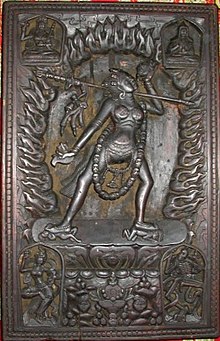A
dakini (
Sanskrit:
डाकिनी ḍākinī;
Standard Tibetan:
མཁའ་འགྲོ་མ་ khandroma,
Wylie:
mkha' 'gro ma,
TP:
kanzhoima; Chinese: 空行母) The dakini is a
tantric figure representing a female embodiment of enlightened energy. The Tibetan form of dakini,
khandroma, translates as 'she who traverses the sky' or 'she who moves in space' or, more poetically, as 'sky walker' or 'sky dancer'.
The dakini is so central to a
Tibetan Buddhist practitioner attaining full enlightenment as a
Buddha that she appears in a
Vajrayana formulation of the
Three Jewels Buddhist refuge formula, known as the
Three Roots. Most commonly she appears as the
dharma protector, alongside a
guru and
yidam, but
Judith Simmer-Brown points out that:
The dakini, in her various guises, serves as each of the Three Roots. She may be a human guru, a vajra master who transmits the Vajrayana teachings to her disciples and joins them in samaya commitments. The wisdom dakini may be a yidam, a meditational deity; female deity yogas such as Vajrayogini are common in Tibetan Buddhism. Or she may be a protector; the wisdom dakinis have special power and responsibility to protect the integrity of oral transmissions[1]
As a key
tantric figure the dakini also appears in other forms of
tantric Buddhism such as the Japanese
Shingon school from where she disseminated into Japanese culture, evolving into
Dakini-ten and becoming linked to the
kitsune iconography. The origins of the dakini figure are uncertain but she continues to this day as a part of Indian folklore, generally in wrathful forms, and remains a part of Hindu tantra.
[edit] In Tibetan Buddhism
Although dakini figures appear in
Hinduism and in the
Bön tradition, dakinis occur most notably in
Vajrayana Buddhism and play a particular role in
Tibetan Buddhism. There the
dakini, generally of volatile or wrathful temperament, acts somewhat as spiritual
muse (or inspirational
thoughtforms) for spiritual practice. Dakinis are energetic beings in female form, evocative of the movement of energy in space. In this context, the sky or space indicates
shunyata, the insubstantiality of all phenomena, which is, at the same time, the pure potentiality for all possible manifestations.
[edit] Classes of Dakini
Judith Simmer-Brown, based on teachings she received from Tibetan
lamas,
[2] identifies four main classes of dakini. These follow
the Twilight Language tradition of
esotericism in referring to secret, inner, outer and outer-outer classes of dakinis.
- The secret class of dakini is Prajnaparamita (Tibetan yum chenmo) or voidness, the empty nature of reality according to Mahayana doctrine.
- The inner class of dakini is the dakini of the mandala, a meditational deity (Tibetan:yidam) and fully enlightened Buddha who helps the practitioner recognise their own Buddhahood.
- The outer dakini is the physical form of the dakini, attained through Completion Stage Tantra practices such as the Six Yogas of Naropa that work with the subtle winds of the subtle body so that the practitioner's body is compatible with an enlightened mind.
- The outer-outer dakini is a dakini in human form. She is a yogini, or Tantric practitioner in her own right but may also be a kamamudra, or consort, of a yogi or mahasiddha.
Dakinis can also be classified according to the
Trikaya, or three bodies of a
Buddha.
- The Dharmakaya dakini, which is Samantabhadri, represents the Dharmadhatu where all phenomena appear.
- The Sambhogakaya dakinis are the yidams used as meditational deities for tantric practice.
- The Nirmanakaya dakinis are human women born with special potentialities; these are realized yogini, the consorts of the gurus, or even all women in general as they may be classified into the Five Buddha Families.[3]
[edit] In Dzogchen
When considered as a stage on the
Vajrayana Path, the dakini is the final stages: the first is the guru, which corresponds to the initial realization of the true condition of reality, as this is introduced by the guru in the
empowerment, if the disciple obtains what the
Inner Tantras call peyi yeshe (
dpe yi ye shes) o the clarity of
shunyata. The second is the
devata, which corresponds to the
meditation insofar as the devata is the method used for developing the state discovered in the initial realization of the true condition of reality. The third stage is the dakini insofar as the dakini is the source of the activities based on the realization of the guru and the meditation of the devata.
In
Dzogchen these three correspond to tawa (
lta ba), gompa (
sgom pa) and chöpa (
spyod pa): the first is the direct vision of the true nature of reality rather than an intellectual view of reality, as is the case with the term in other vehicles; the second is the continuity of this vision in sessions of meditation; and the third is the continuity of this vision in everyday activities. As a tantric practice, imperfections are utilised to make the vision uninterrupted. As the Base, the dakinis are the energies of life; as the Path, they are the activities of advanced practitioners; as the Fruit, they are the actionless activities of realized Masters.
[3]
[edit] In Anuttarayoga Tantra
Being associated with energy in all its functions, dakinis are linked with the revelation of the
Anuttarayoga Tantras, which represent the path of transformation, whereby the energy of negative emotions or
kleshas, called poisons, is transformed into the luminous energy of enlightened


